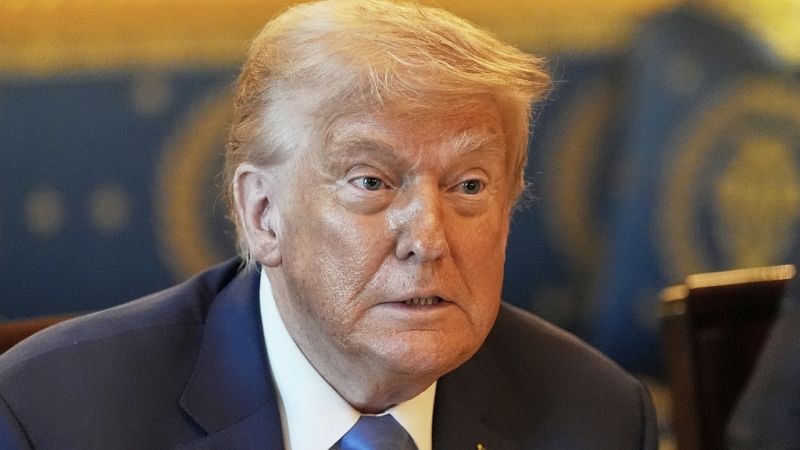
When President Donald Trump last rolled out tariffs this high, financial markets quaked, consumer confidence crashed, and his popularity plunged.
Only three months later, he's betting this time will be different.
When Trump announces a new round of tariffs this week, he is betting that import taxes will deliver factory jobs and stronger growth in the US. Many economists are nonetheless predicting the opposite, forecasting that duties will stoke inflation and usher in an economic slowdown.
On Tuesday, Trump told his Cabinet that past presidents who hadn't aggressively deployed tariffs were "stupid". Ever the salesman, Trump added that it was "too time-consuming" to try to negotiate trade deals with the rest of the world, so it was just easier to send them letters, as he's doing this week, that list the tariff rates on their goods.
The letters mark a change from his self-proclaimed 2 April "Liberation Day" event. Speaking in the White House's Rose Garden earlier this year, the president held posterboards with the rates displayed. The display led to a brief market meltdown and a subsequent 90-day tariff pause, which brought about 10% baseline duties, that will end on Wednesday.
"It's a better way," Trump said of his letters. "It's a more powerful way. And we send them a letter. You read the letter. I think it was well crafted. And, mostly it's just a little number in there: You'll pay 25%, 35%. We have some at 60, 70."
When Trump made those comments, he had yet to issue a letter with a tariff rate higher than 40%, which he levied Monday on Laos and Myanmar. He plans to put 25% tariffs on Japan and South Korea, two major trading partners and allies deemed crucial for curbing China's economic influence. Leaders of the 14 countries who have received tariffs so far hope to negotiate over the next three weeks — before the higher rates kick in.
"I would say that every case I'm treating them better than they treated us over the years," Trump said.
The president said on Tuesday evening on Truth Social that he would be releasing letters to "a minimum of 7 Countries" on Wednesday morning, with additional letters coming out in the afternoon.
Three possible outcomes
Trump's approach is at odds with how major trade agreements have been produced over the last 50 years. Typically, this involved detailed sessions, with nations often taking years to work out complex differences.
There are three possible outcomes to the president's political and economic wager, each of which could drastically reshape international affairs and Trump's legacy.
On one hand, Trump could prove most economic experts wrong and the tariffs could deliver growth as promised. Alternatively, he could retreat again on tariffs before their 1 August start.
A third possibility is that the president could damage the economy in ways that could particularly harm poorer communities that voted for him.
Democratic senator Ron Wyden from Oregon said Trump's letters had "extended his tariff purgatory for another month", holding the US in a period of uncertainty as CEOs, foreign leaders and consumers wait for a clearer policy stance.
"The TACO (Trump Always Chickens Out) negotiating tactic pioneered by Trump is making his threats less and less credible and reducing our trading partners' willingness to even meet us halfway," Wyden said. "There's no sign that he's any closer to striking durable trade deals that would actually help American workers and businesses."
In Tuesday trading, stock markets were relatively calm in the US, with the S&P 500 essentially flat after a Monday decline.
Trump is coming off a legislative win after his "Big Beautiful Bill" passed through congress, laying out multitrillion-dollar income tax cuts.
And he's confidently levying tariffs at levels that previously rocked global markets, buoyed by the fact that inflation has eased so far instead of accelerating as many economists and Democratic rivals had warned.
"By floating tariffs as high as 40% to even 100%, the administration has 'normalised' the 25% tariff hikes — yet this is still one of the most aggressive and disruptive tariff moves in modern history," said Wendong Zhang, an economist at Cornell University. "This gradual unveiling, paradoxically, risks normalising what would otherwise be considered exceptionally large tariff hikes."
Others simply see Trump as a chaotic force, with the letters and their somewhat random tariff rates showing the absence of a genuine policy process inside his administration.
"It's really just a validation that this policy is all over the place, that they're running this by the seat of their pants, that there is no real strategy," said Desmond Lachman, a senior fellow at the American Enterprise Institute, a right-leaning think tank.
Questions about how much money tariffs will generate
With Trump's 90-day tariff negotiation period coming to a close, the president had on Monday sent letters to 14 countries, placing taxes on imported goods ranging from 25% to 40%. He said on Tuesday he would sign an order to place 50% tariffs on copper, and he added that at some point, pharmaceutical drugs could face tariffs of up to 200%. He has already placed 50% tariffs on steel and aluminium, 25% tariffs on autos, and separate import taxes on Canada, Mexico and China.
"The obvious inference is that markets for now are somewhat sceptical that Trump will go through with it, or alternatively they think compromises will be reached," said Ben May, a director of global economic research at the consultancy Oxford Economics. "That's probably the key element."
May said the tariffs are likely to reduce the growth in US household incomes, but not cause those incomes to shrink outright.
Trump has said his tariffs would close US trade imbalances, though it's unclear why he would target nations such as Tunisia that do relatively little trade with America.
Administration officials say trillions of dollars in tariff revenues over the next decade would help offset the revenue losses from the continuation and expansion of his 2017 tax cuts that were signed into law on Friday.
The federal government has collected $98.2 billion (€83.9bn) in tariff revenues so far this year, more than double what it collected last year, according to the Bipartisan Policy Centre.
At Tuesday's Cabinet meeting, Treasury Secretary Scott Bessent said the tariff revenues could be "well over $300bn (€256bn) by the end of the year".
Bessent added that "we don't agree" with the Congressional Budget Office estimate that tariffs would bring in $2.8 trillion (€2.4tr) over 10 years, "which we think is probably low".
The governments of Japan, South Korea, Malaysia, Myanmar, Thailand, Cambodia and South Africa have each said they hope for further negotiations on tariffs with Trump, though it's unclear how that's possible, as Trump has said it would be too "complicated" to hold all those meetings.
Instead, on Tuesday, Trump posted on social media that the tariffs would be charged as scheduled starting 1 August.
"There has been no change to this date, and there will be no change," Trump said on Truth Social. "No extensions will be granted."







